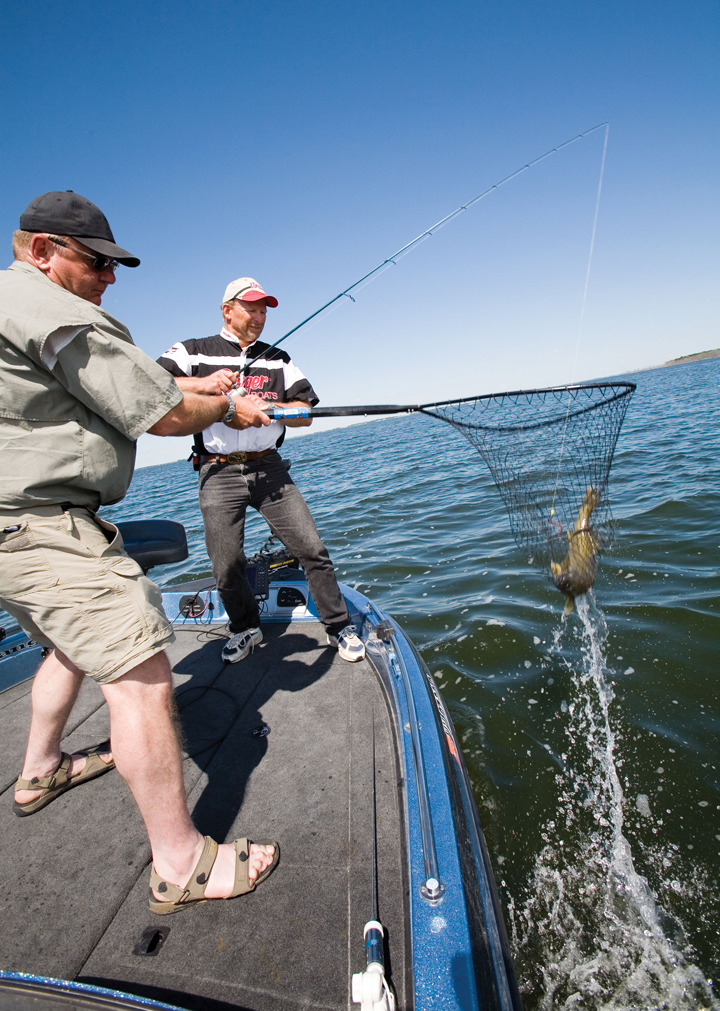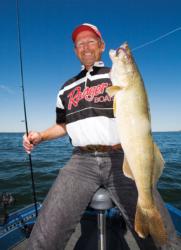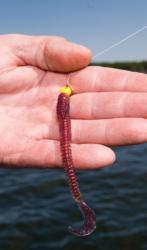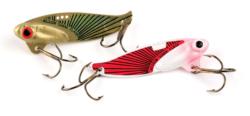Tailwater trophies
Whether you’re fishing in the heat of summer or the dead of winter, tailrace waters below dams mean a shot at the biggest walleyes in the river

When you see walleye boats out fishing on just about any walleye river in the country, there’s almost always a gaggle of them tucked up tight below a dam. It may not be the most aesthetic place to fish, and it’s certainly not the most peaceful. It’s sometimes not the safest or easiest either, with dumping currents and swirling back eddies and jagged concrete berms and snags galore.
But the upside is this simple truth: This is where the walleyes are, and a lot of the time this is where the biggest walleyes are. Fishing below dams eliminates one whole variable – you don’t have to wonder if there are fish down there, because there are. Walleyes love tailwaters. They love them for the energy-activating oxygen they provide; for the structure that allows them to hide and ambush prey; and for the wealth of edible things coming down to them as they course through the spillways. The mile or two below a dam is a veritable buffet and walleyes know it.
Experience counts
No matter how long you’ve been a walleye angler, chances are that 51-year-old Terry Wilson of Powell, Wyo., has spent more time on the water than you and on more water to boot. His walleye chasing has rambled from the Great Lakes to Minnesota to the Dakotas and onto river systems and reservoirs farther west. There aren’t too many places he hasn’t fished. He’s seen it all as a full-time tournament pro whose recent accomplishments include winning the 2005 PWT tournament at Sault Ste. Marie on the St. Mary’s River and a fourth-place finish on Saginaw Bay during a 2002 Wal-Mart FLW Walleye Tour event.
For Powell, tailwaters are a year-round attraction, even if there isn’t a tournament anywhere nearby. “During my breaks from tournaments, just fishing with friends, I like to hit the dams,” he said.
Specifically, Powell’s all-time favorite is below Red Wing, Minn., at Lock and Dam No. 3 down to Pool No. 4 on the Mississippi River, sight of the second regular-season FLW Walleye Tour event of 2006.
“When I take my breaks between tournaments, that’s where I stop and take friends,” Powell said. “Winter fishing, spring fishing, summer fishing … I really like Lock and Dam No. 3.”
Wilson is also fond of the dams in South Dakota – below Francis Case, for example.
“What attracts me is, first of all, we usually do really well below dams. Secondly, when other walleye seasons are closed, like in Minnesota, the river is still open,” Powell said. “So you can fish in the winter. But it’s not just a winter fishery. You can fish below dams any day of the year and catch fish. Tailraces are especially good in the summertime; a lot of people don’t realize that. Heck, they’re good 12 months  out of the year. What you’ll find is reservoirs are more stable, and fishing in reservoirs means you can troll. But the bigger fish are in the tailraces, right on the bottom, and you have to be good at vertical jigging to catch them.”
out of the year. What you’ll find is reservoirs are more stable, and fishing in reservoirs means you can troll. But the bigger fish are in the tailraces, right on the bottom, and you have to be good at vertical jigging to catch them.”
Tailwater strategies
Given all this, where do you start fishing? The answer to that is one of the many blessings of this kind of fishing. “The walleyes in rivers always relate to current breaks, just like they’re always on the bottom – not up high, not suspended. They sit on those breaks, right on the bottom, and wait for the current to bring food to them. So that’s what you look for – current breaks,” Wilson said.
Depth may be the most challenging thing to figure out.
“You have to really watch your electronics,” Wilson continued. “When you start marking fish, that’s the depth to work, because fish are finicky about the depth they’re going to be at. If you mark fish or catch a fish at 15 feet, or 17 feet, or whatever, you’ve got to stay fairly close to that depth and really work it. That’s when boat control is so important. As soon as I find the depth where I’m catching fish, I try to keep the boat at that depth.”
Wilson relies on a controlled drift most of the time, working the edges of the current breaks and eddies – anyplace, really, where a walleye can rest out of the pounding current while still being able to swiftly sup up anything of interest that passes by.
“Sometimes the current is really rocking, just going flat out, and sometimes it’s not,” Wilson said. “But a lot of the time it’s not so bad. So you can make a controlled drift. Of course, if I really get on the fish, I’ll try to hold over them in the current and work that area better. You get on your bow-mount electric and either try to match the drift to the speed of the current or try to hold to work an area.”
Tailwater lures, baits and presentations
A critical factor that can’t be emphasized enough is to present whatever you’re presenting as straight-up-and-down vertical as you can get it. This is paramount – not only for detecting the strike and getting a good hookset, but also to avoid snagging up.
For this pro, his go-to, all-time favorite presentation is to jig a plastic on a jighead with one rod and a metal lure on the other. Once he sees a pattern – that is, what the fish are telling him they want – he switches both rods to that.
“One of my favorites is the ringworm,” Powell said. “I’ll fish a ringworm plastic on a jighead on one rod and a metal lure on the other rod, like a blade bait, Rapala jigging spoon or a Nils Master. Some of these are actually ice-fishing jigs, but they work year-round. On the Mississippi, my favorite is the ringworm. I  don’t use live bait below dams because I don’t think you have to. Live-bait dealers hate me because I almost always use just metal and plastics.”
don’t use live bait below dams because I don’t think you have to. Live-bait dealers hate me because I almost always use just metal and plastics.”
For his jigheads, Wilson said color doesn’t enter into the equation.
“On some days it might make a difference and I’ll start with a chartreuse jighead, chartreuse-orange or a chartreuse-lime. But I think what the walleyes are really interested in is the profile of the plastic and the color of the plastic. So most of the time I’m using just a plain, lead-colored jighead.”
Wilson favors ringworm plastics made by Zoom, Mister Twister and Berkley.
“I keep a wide selection of colors in the boat, and I play with colors quite a bit. Walleyes want one color one day and another color the next day. I use plastics that are 4 to 5 inches in length. Purple has been a good color for me this year and so has chartreuse and orange.”
The Wyoming pro fishes these with the hook exposed, tying them directly to 10- to 14-pound FireLine without a leader.
“If you get hung up, you just pull it out and straighten the hook,” he said. “I swing it into the boat, resharpen and reshape the hook, and I’m ready to fish some more. I don’t like to take a lot of time retying. That’s not the point of fishing.”
Again, the central theme is to fish close to the bottom.
“The way I work them, I keep them as close to the bottom as possible. You have to remember, below the dams, walleyes don’t suspend, and they don’t come up high. You have to fish it right there, in their face.”
In his years of doing this, Wilson has perfected a technique he’s comfortable with that catches fish.
“Whether it’s a jigging shad or a jig and plastic or a blade bait … doesn’t make any difference. I go down and make contact with the bottom then pull it up and keep it a couple inches above the bottom.”
One of the things that keeps weekend anglers from catching more fish, Wilson believes, is imparting too much action to the jig or metal lure.
“There’s not a lot of action required,” he said. “If you’re jigging it real actively, you’re pulling it up out of  the strike zone. That strike zone is really, really close to the bottom.”
the strike zone. That strike zone is really, really close to the bottom.”
Detecting the strike
Wilson said that, often, when he drops his jig, the fish is already there.
“The only way you can tell if there’s a strike is if there’s just a slight, tiny bit of slack in the line. That’s when you set the hook because the fish has already taken it. It’s amazing to me some of the sizes of the fish, and you won’t even feel them grab it.”
But it isn’t always that way, particularly in the summer months.
“Some days, they’ll take the pole right out of your hands,” Wilson said. “They’ll just take your arm off. But other days, they’re just there. It’s a real finicky bite, and you won’t feel it, no matter how big the fish is. I find that really amazing.”
This is where keeping your line as vertical as possible comes into play, for not only properly presenting the lure, but also to detect the strike.
“You’ve got to try to keep your lines as vertical as you can,” Wilson repeated. “Boat control is the real key. If you’re snagging up a lot, you’re not vertical enough. If you’re having trouble, try going with a heavier jighead. Of course, you should fish with the lightest jighead you can that still makes it possible to contact the bottom and stay vertical, but experiment with the weight and with your bow-mount speed to keep your lines vertical.”
Wilson said one other factor determines the weight of your lure, and that’s whether the water is stained or not.
“If the water’s dirty, go bigger,” he said. “Put a bigger profile in the water.”
This roily world of noise, current, turbidity and food is the perfect environment for walleyes; a kind of heaven and haven at the same time. It’s not the most attractive or inviting setting for a fisherman and his boat, but it is productive fishing nonetheless. The biggest walleyes of many a walleye-fishing lifetime have been pulled from waters below a dam, and that is a trend not likely to change.
Select tailwater hot spots for walleyes
Tailwater fisheries are located all over the country – any place there’s a river with a dam on it that offers walleyes, saugers or saugeyes. Some are huge, with tremendous current speed, and some are gentler and slower:
Below Boysen Dam in Wyoming:
This is a smaller, lesser known but highly productive tailwater. “This is a smaller tailwater, and you really can’t get a big boat in on it. But you can get a smaller boat in, and it’s worth the effort,” said Wyoming pro Terry Wilson. There may be more trout anglers there than walleye anglers, but that’s OK – there are plenty of undisturbed walleyes as a result on the bottom of the Wind River below the dam.
Below Lake Sharpe and Oahe Reservoir tailwaters:
Famous and productive, both of these reservoirs in North and South Dakota on the Missouri River and the tailwaters that flow beneath them are legendary for their walleye fishing – not only for impressive numbers, but for size.
Below McNary Dam in Washington/Oregon:
The Pacific Northwest may be most notable for coldwater species like steelhead, salmon, trout and kokanee. But the east-west flowing Columbia River, serving as the boundary between Washington to the north and Oregon to the south, is a consistent trophy walleye producer. One of the most popular stretches is between Umatilla and Boardman, Ore., just below McNary Dam.
Tippecanoe River in Indiana:
This is a sleeper of a tailwater, but it’s particularly good as a springtime fishery. Though the Hoosier State isn’t necessarily noted for its walleye fishing – there’s little natural reproduction, and stocking must support the fishery – the Tippecanoe River has booted out walleyes to 14 pounds, 4 ounces (the current state record), and saugers to 6 pounds, and sports good to excellent walleye fishing below dams at places like Freeman and Mississinewa.